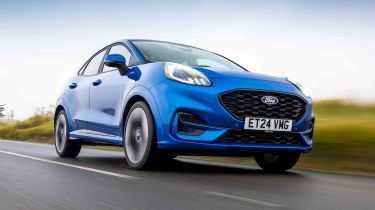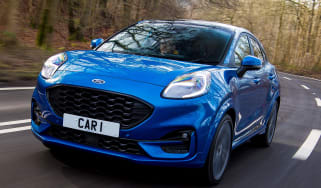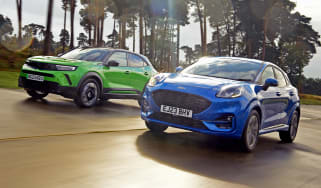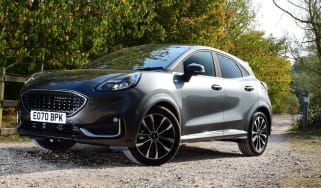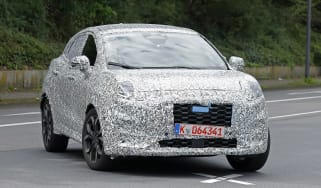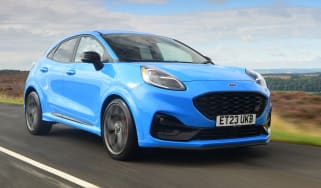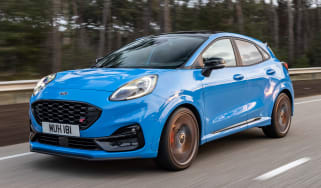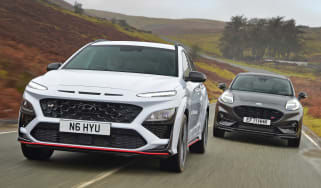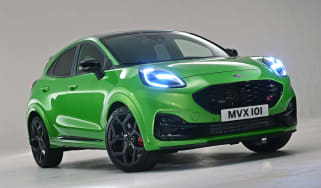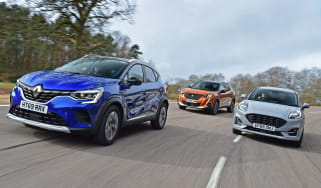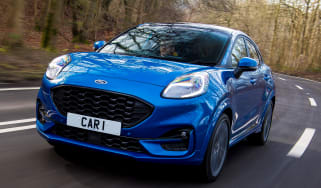Ford Puma review
The refreshed Ford Puma compact SUV is still the best-handling car in its class

Our opinion on the Ford Puma
If cars could feel emotions such as pressure, then the Ford Puma would likely have had a bit of a sweat on for most of its five-year life so far. Not only did it arrive with some hostility from Ford fans who remembered the original Puma – an affordable yet utterly brilliant Fiesta-based coupé – but more recently, it has superseded the iconic supermini as the brand’s smallest car. Given that model’s decades-long success, taking its place was a mammoth task.
But the Puma has acquitted itself very well. Although it wouldn’t outhandle the original Puma coupé, it was still easily the best car to drive in the flourishing small SUV segment. Indeed, only its low-rent cabin let the side down. However, the 2024 facelift brought subtle exterior design changes and, more significantly, introduced an overhauled dashboard layout, which addressed that flaw. Not too long after the facelift, the Puma Gen-E arrived in the UK, and this finally brought this top-selling SUV into the electric car market.
| Key specs | |
| Fuel type | Petrol |
| Body style | Five-door, five-seat small SUV |
| Powertrain | 1.0-litre 3cyl turbocharged petrol, front-wheel drive |
| Safety | 4-star Euro NCAP (2022) |
| Warranty | 3 years/60,000 miles |
About the Ford Puma
With the demise of the Fiesta, the Ford Puma is now the cheapest car in the company’s line-up. It starts from around £26,000, which gets you behind the wheel of a 123bhp 1.0 EcoBoost Titanium with a six-speed manual gearbox.
Used - available now
The most recent facelift in 2024 saw the range rejigged so that all versions are now powered by Ford’s 1.0 EcoBoost three-cylinder turbocharged petrol engine with mild-hybrid assistance. This has power outputs of 123bhp, 153bhp and 168bhp, with the latter being the only engine now offered in the ST performance flagship - the 1.5 EcoBoost has been dropped.
There are six-speed manual and seven-speed automatic gearbox options for the least powerful EcoBoost motor, while the other two options come as standard with the seven-speed automatic.
While the original Ford Puma was a fun, small, front-wheel-drive Fiesta-based coupe that was launched in 1997, the current car is about as far removed from that as you can get. It’s still based on the now-discontinued Fiesta, but takes on the form of a small five-door SUV.
It’s based on the seventh-generation supermini (that has sadly ceased production), and uses the same chassis and engines. Unlike the Fiesta, though, the Puma now has a fully-electric sibling called the Puma Gen-E.
The Puma trim structure has been slimmed down when compared with the pre-facelift car, and the petrol model now has four core versions: Titanium, ST-Line, ST-Line X and the performance-focused but quite disappointing Ford Puma ST. The electric Gen-E line-up, meanwhile, consists of Select and Premium trims. We’re focusing on the combustion Puma on this page, but you can read our dedicated, in-depth Ford Puma Gen-E review here…
Titanium has all the goodies you’d hope for in a small SUV, including 17-inch alloy wheels, power-folding mirrors, a rear parking camera with sensors, cruise control, selectable drive modes and a 12-inch central touchscreen.
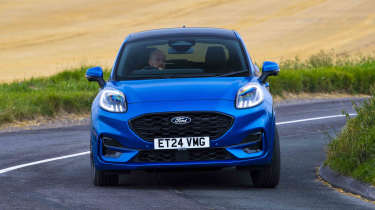
ST-Line models include a muscular bodykit, sports suspension, a leather sports steering wheel and alloy pedals, while ST-Line X cars come with stylish 18-inch wheels, privacy glass, a powered bootlid, a wireless charging pad for your smartphone and a 10-speaker Bang & Olufsen sound system. The sportiest ST features 19-inch alloy wheels, a body styling kit, Ford Performance seats, a 360-degree camera and a more powerful engine.
New Pumas start at £26,580 for the base trim and reach up to £33,880 for higher-spec versions. Used Pumas are widely available too, with prices ranging from approximately £10,000 to £16,000, depending on age, mileage, and condition. Leasing options are also competitive, with monthly payments starting from about £240 for the base trim on a personal lease, with an initial payment of around £2,000.
With its higher trim levels and electric powertrain, you’d be forgiven for assuming that the Puma Gen-E would carry a much higher starting price than its petrol-powered counterpart. However, this model starts from £29,995, which is a much smaller price gulf than some other rivals that come in both combustion and EV forms, such as the Peugeot 2008 or Hyundai Kona.
If you, like many other UK drivers, fancy having a Ford Puma on your driveway, our Find a Car service is here to help. You can also configure your ideal Ford Puma and receive great offers from our network of dealerships, take a look at the best Puma leasing deals or choose from a huge selection of top-notch used Puma models. Need to sell your car? Be sure to visit our Sell My Car page.
Performance & driving experience
|
Pros |
|
| Cons |
|
Ford has earned a reputation for producing a range of everyday cars that appeal to the keen driver after decades of sharp-handling hatchbacks. The Puma lives up to that, and when it comes to handling, it still has the beating of its competition when it comes to fun. However, the powertrains are not without their faults, which mainly focus on the shortcomings of Ford’s seven-speed automatic gearbox.
Performance, 0-60mph acceleration and top speed
All versions of the Ford Puma can accelerate from 0-62mph in less than 10 seconds, with the slowest model being the 123bhp manual model, which has a time of 9.8 seconds. Adding the seven-speed auto sees a couple of tenths shaved off for a time of 9.6 seconds.
The auto-only 153bhp version of the EcoBoost engine has an official 0-62mph time of 8.7 seconds, while the auto-equipped Puma ST can accelerate from 0-62mph in 7.4 seconds. That’s with the overboost function activated, which automatically cuts in when using full throttle to give the maximum 168bhp. At all other times, maximum output is restricted to 158bhp to help save wear and tear on the car’s running gear.
The Puma uses a mild-hybrid system to help boost performance while also making it more efficient, but the only downside to the mild-hybrid system is that to fill the small battery pack with energy, the Puma features a very minor amount of brake energy regeneration. It’s set at a constant, unchangeable level that’s just about detectable when you lift off the throttle and feel the car slow more quickly than it otherwise would, and takes a little getting used to.
The electric Puma Gen-E does a respectable job of carrying over this small SUV’s fun factor while cutting out exhaust emissions. You can read more about this model’s performance in our dedicated in-depth Ford Puma Gen-E review…
Town driving, visibility and parking
Many of the Puma’s controls, from the steering to the clutch, are light and precise, so it feels very easy to drive around town. The turning circle is excellent, and the supermini-sized dimensions make the Ford simple to place on the road and park.
The automatic gearbox is smooth at low speeds, although the three-cylinder engines do produce a noticeable amount of vibration both at idle and under acceleration.
B-road driving and handling
The Puma is still by far the best-handling car in the segment. It’s agile, grippy and sweetly balanced, with sharp, positive steering to make even the most mundane journeys enjoyable.
While the ride is on the firm side of the class, it’s not crashy. The positive body control helps negotiate some bumps, too, because over uneven and adversely cambered roads, the body doesn’t get thrown around as much as it does in some other small SUVs.
However, we’d avoid going too high up the Puma range if you can, because ride comfort on ST-Line X models – equipped with 19-inch wheels and uprated suspension – is certainly treading a fine line between a sporty feeling and outright bumpiness.
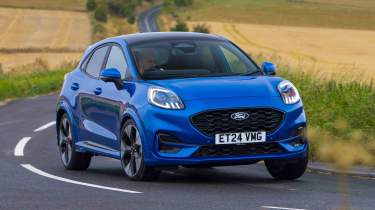
People who like a car that responds quickly to inputs would do well to avoid the automatic gearbox. It’s very slow and unresponsive when driving keenly, which means it’s frequently bogged down when entering a corner. Sport mode helps because it holds a lower ratio, but that still means you’re at least one gear too high for a corner, rather than two or three when in normal mode.
This situation is compounded by the fact that there’s no manual override available with the automatic transmission, which completely kills the fun. This would be fine if Ford offered each version with a manual gearbox, but the two most powerful engines – including the ST – are only available with the auto.
Motorway driving and long-distance comfort
The EcoBoost units, which can be slightly thrummy at lower speeds, settle down into a quiet cruise. Decent torque figures mean that they generally feel fairly strong when accelerating up to 70mph, too. The base model’s 0-62mph time of 9.8 seconds will be more than enough for most buyers.
| Model | Power | 0-60mph | Top speed |
| 1.0 EcoBoost mHEV 125 Titanium | 123bhp | 9.8s | 119mph |
| 1.0 EcoBoost mHEV 155 Titanium auto | 153bhp | 8.7s | 124mph |
| 1.0 EcoBoost mHEV 125 ST auto | 168bhp | 7.4s | 130mph |
“What still impresses me about the Ford is the amount of torque from its tiny 1.0-litre engine. Even when it’s loaded up with all my camera gear the Puma has a great turn of pace and the engine pulls really strongly right up to the top end. It does create a noticeable amount of noise in the lower gears, but it’s easy to forgive this for the overall package.” - Pete Gibson, senior photographer, who lived with a pre-facelift Ford Puma ST-Line for six months.
MPG & running costs
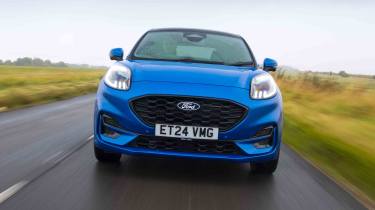
|
Pros |
|
| Cons |
|
With a fuel economy figure of 52.3mpg, the Puma mHEV with the 123bhp engine and a manual transmission looks promisingly frugal on paper. When we ran the 153bhp mHEV on our test fleet, we averaged 44.3mpg, which was a decent, if not outstanding, return for a car of this size.
Those figures are helped by the mild-hybrid powertrain, which recovers energy that would otherwise be lost when slowing down or braking via an integrated starter/generator unit, and stores it in a 0.48kWh battery. This can then be used to reduce load (and therefore fuel usage) on the petrol engine for any subsequent acceleration. The set-up also allows the stop-start system to operate quickly and almost seamlessly.
Drivers can view a display on the digital instrument panel to see exactly when the system is in action. Alongside this, cylinder deactivation means the engine can run on two cylinders where driving conditions allow it to save more fuel.
Despite the extra power, the performance ST model still achieves decent economy, with a WLTP-tested figure of 47.1mpg, although CO2 levels are a little higher at 136g/km.
Every combustion-powered Puma is reasonably efficient, but those who desire the lowest running costs may wish to read up on the fully-electric Puma Gen-E.
| Model | MPG | CO2 | Insurance group |
| 1.0 EcoBoost mHEV 125 Titanium | 52.3mpg | 122g/km | 12E |
| 1.0 EcoBoost mHEV 155 Titanium auto | 49.6mpg | 128g/km | 17E |
| 1.0 EcoBoost mHEV 125 ST auto | 47.1mpg | 136g/km | 21E |
Insurance groups
Insurance premiums for the Puma range should be competitive with those of rivals. The base 123bhp Titanium model comes in at group 12, moving up to group 17 for the more powerful 153bhp version of the same engine. Understandably, the hotter ST model costs the most to insure in the Puma range, with the 168bhp 1.0-litre coming in at group 21. The electric Gen-E line-up, meanwhile, starts from group 18.
This means some competitors manage to slightly undercut the Puma on insurance costs. For example, the Renault Captur has a less powerful 99bhp 1.0-litre model, which starts at group 11, moving to group 16 for the more powerful 1.6-litre E-Tech hybrid.
Tax
Regardless of which model you choose, every Puma carries the standard rate of vehicle excise duty (VED). This also includes the Puma Gen-E, thanks to road taxing changes back in April 2025.
The electric Puma Gen-E will best serve company car buyers, because EVs currently attract the very lowest Benefit-in-Kind rate at just three per cent, which is much lower than a traditional petrol or diesel car.
Depreciation
Over the course of three years and 36,000 miles, the Puma holds its value well when compared with its competitors. The Ford is predicted to retain between 38 and 54 per cent of its original value, compared with 44 to 49 per cent for the Nissan Juke and 48 to 50 per cent for the Skoda Kamiq.
To get an accurate valuation for a specific model, check out our free car valuation tool...
Interior, design & technology
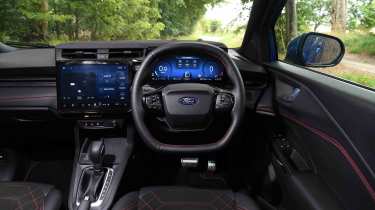
|
Pros |
|
| Cons |
|
The cabin in the face-lifted Ford Puma has been transformed. Not only has the dashboard been overhauled to accommodate the latest version of Ford’s SYNC infotainment set-up, but the air vents have now moved to the top of the dash from their previous position lower down. The steering wheel is also new, and the slightly squared-off shape is similar to the item used in the latest Ford Transit Custom, but it suits the Puma’s sporty character well.
Sometimes it’s the simplest technology that is the most useful. Ford’s Quickclear heated windscreen, a feature that first appeared on the brand’s models in the 1980s, is still a fantastic feature for the winter months. More recent tech inclusions include the digital dials, which are sharp and clear, but the same can’t be said of the reversing camera, which has a relatively low resolution. The Puma has four USB ports, with one USB-A socket, and the rest being USB-C connections.
Interior and dashboard design
From an ergonomic point of view, the Puma now features just one steering-column stalk. It’s on the left-hand side and caters for the front and rear wipers, plus the headlight flasher and indicators. The main lighting controls are now adjusted via a panel on the dashboard to the right of the steering wheel.
A complete cabin redesign was needed so Ford could cram its huge touchscreen into the dashboard. It has slightly raised the level of the dash, so forward visibility isn’t quite as clear as it once was.
There are other ergonomic compromises, too. The new pad to hold a smartphone (or charge it wirelessly) isn’t very well thought out because it leans backwards towards the cabin. While a phone stays in place for the most part, it’d be more secure if it were leant forward, away from the gear selector and handbrake.
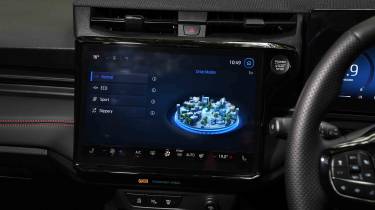
Materials and build quality
The 2024 updates have certainly helped boost the feeling of quality inside the Puma. While a Peugeot 2008 still outshines most of the competition in terms of material finish, the Ford no longer feels like it lags behind.
There are still some hard plastics dotted around the Ford’s interior, but these aren’t as noticeable as they were before thanks to the leather-effect trim added to the dashboard and door panels.
Infotainment, sat-nav and stereo
The Puma’s SYNC infotainment features Amazon Alexa voice control as part of its interface. But while the system is an improvement over the older version and is fine in isolation, against the best in this sector, its weaknesses are highlighted. At 12 inches, the display is among the largest in this class. But while it’s big, it’s not quite as clever as we’d hoped.
Compared with the class-leading Renault Captur, the mapping screen isn’t very detailed, and there’s a noticeable delay when booting up. The panel isn’t as responsive to touches as the Renault, either. That’s a big deal, given that the climate settings are entirely adjusted through the screen.
A six-speaker sound system comes as standard with Titanium, but upgrade to ST-Line X, and you’ll get a 10-speaker audio set-up from Bang & Olufsen, plus a wireless smartphone charging pad.
“The Puma’s cabin always felt a comfortable and well laid-out environment to climb into after a long day out on location. I really appreciated the quick-clear heated windscreen and the heated steering wheel on colder, wetter days, and the very logical layout meant that it was all easy to use.” - Pete Gibson, senior photographer, who lived with a pre-facelift Ford Puma ST-Line for six months.
Boot space & practicality
|
Pros |
|
| Cons |
|
The Ford Puma isn’t quite class-leading for interior space and boot capacity, but given its small footprint, it makes great use of its size.
Like most of its rivals, the Puma is a five-door small SUV. It has five seats, although if you have adults to transport, it's best thought of as a four-seater with just enough room for a fifth passenger on a short journey.
| Dimensions | |
| Length | 4,186mm |
| Width | 1,805mm |
| Height | 1,536mm |
| Number of seats | 5 |
| Boot space | 456-1,216 litres |
Dimensions and size
The Puma is one of the smaller options in the supermini-sized SUV class. It measures 4,186mm in length (4,226mm for the ST), 1,805mm wide and stands 1,536mm tall. By comparison, the Peugeot 2008 and Mazda CX-30 are 114mm and 209mm longer, respectively.
Driving position, seats & space in the front
The driving position feels sportier than most rivals due to good seat bolsters, while there’s a great deal of adjustment in the seat and steering wheel, a typical Ford trait.
Even though the combustion Pumas come with a manual handbrake – which is a rarity on new cars these days – and a fairly chunky gear selector, there’s still sufficient space in the centre console for a neat triple cup-holder arrangement.
Elsewhere, there’s a large glovebox, and the door bins are wide and deep. A storage area is located under the central armrest, and inside it is a useful small tray so that items such as keys don’t completely disappear into the void.
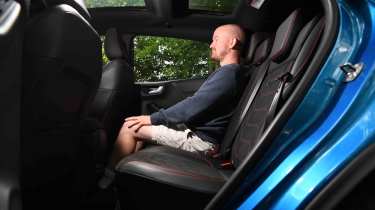
Seats & space in the back
Look beyond the small door bins in the rear door cards (which are finished entirely in scratchy plastic and leave the rear occupants feeling short-changed when it comes to quality), and the Puma offers up enough space for adults.
There is loads of foot space beneath the front seats for occupants to make the most of the knee room on offer, while even the centre seat, although a little narrow, is quite soft and comfortable. If you plan to carry tall passengers frequently, it’s best to avoid the panoramic sunroof option, because its bulky mechanism compromises headroom.
Fitting a child seat is a little fiddly, however, because the two sets of ISOFIX mounts on the outer chairs are buried between the seat cushions.
Boot space
A 456-litre boot (which grows to 1,216 litres with the rear seats folded) is impressive considering the Puma’s compact footprint. The Megabox storage area beneath the standard boot floor helps this capacity. This 68-litre plastic container features a drain plug at its bottom, making it ideal for storing dirty items, such as boots, because it can be rinsed out when it becomes grubby.
A 12-volt socket in the boot area means it’s also possible to power a range of accessories. One slight flaw comes with the parcel shelf, however. The fabric sheet is very flimsy, and its clips fall apart easily. These soon broke on the pre-facelift Puma we ran on our long-term test fleet, meaning what was, in effect, a brand-new model, was quickly damaged.
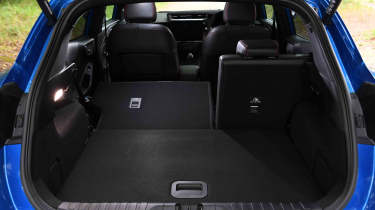
Towing
The 123bhp version of the 1.0-litre EcoBoost engine can tow a small braked trailer weighing up to 1,100kg thanks to its manual gearbox, while the automatic used in the 153bhp version and the 168bhp ST reduces capacity to 900kg. That’s at the lower end of the scale, meaning those after more serious pulling power must go for the Volkswagen T-Roc, which can tow up to 1,500kg.
“Once I’ve put the boot floor down and filled the total 456 litres available, it will easily take my camera bag, tripod, flash stands, cleaning gear, harness – the list goes on. What that means is that the cabin is kept free of this clutter.” - Pete Gibson, senior photographer, who lived with a pre-facelift Ford Puma ST-Line for six months.
Reliability & safety
|
Pros |
|
| Cons |
|
Ford’s 30th-place finish in the 2024 Auto Express Driver Power customer satisfaction survey means that the manufacturer beat only Fiat and MG to avoid the bottom spot. Far fewer owners of the Italian brand’s models (11.8 per cent) experienced faults in their first year of ownership than Ford drivers (20.8 per cent), too.
The Puma’s Euro NCAP safety rating also slipped following a retest in 2022, where it found itself downgraded from a five-star result to four stars. The industry safety body criticised the Puma’s front seat and headrest design, but it isn’t the only small SUV to receive a four-star score; the Hyundai Bayon and Vauxhall Mokka also came up short under the same assessment. If you’re looking for rivals offering a five-star rating, then you should look at the SEAT Arona or Toyota Yaris Cross.
The Puma does win back some points because it features all the safety technology you’d expect, including cruise control, a lane keeping aid with departure warning, Pre-Collision Assistance with Autonomous Emergency Braking, Pedestrian/Cyclist Detection and Post-Collision Braking. Other useful features include auto headlights, rain-sensing wipers and a tyre pressure monitoring system.
Those wishing to upgrade further can opt for the Driver Assistance pack (£950), which adds a blind spot warning, adaptive cruise control and a rear-view camera, among other features.
Every new Puma comes with a three-year, 60,000-mile warranty from Ford. Many rivals now offer owners a stronger, longer package than this, including Kia (seven years, 100,000 miles), MG (seven years, 80,000 miles) and Hyundai (five years, unlimited mileage).
Ford offers a competitive service plan for the Puma, which comes to £370 based on a three-year agreement. Unusually, Ford recommends a service every two years or 18,000 miles, whichever comes first.
| Key standard safety features |
|
| Euro NCAP safety ratings |
|
Buying and owning
- Best buy: Ford Puma 1.0 EcoBoost mHEV Titanium
While the older Ford Puma ST was a lot of fun to drive, yet remained pretty practical, this model has since been downgraded with a far less powerful engine and hobbled with a disappointing automatic gearbox. We believe that the entry-level Titanium model with a manual gearbox is the best of the bunch.
Not only is it the cheapest Puma to buy brand-new, but the entry-level model still offers family-friendly space, a generous helping of standard kit and an enjoyable level of performance. We’d avoid the automatic gearbox unless you really need one, because it can be frustratingly dimwitted in its operation.
Ford Puma alternatives
The small SUV sector is choc-full of options as numerous carmakers attempt to take their slice of this lucrative market. The result is a list of attractive Puma alternatives that’s seemingly never-ending.
The Vauxhall Mokka, Hyundai Kona, Kia Niro, Renault Captur, Nissan Juke, Peugeot 2008 and Citroen C3 Aircross are just some of the many similarly priced competitors that the Puma must contend with. If driving enjoyment is your priority, none of these models can beat the Ford, but several do outshine it when it comes down to a crucial SUV quality: practicality.
Latest deals on the Puma and rivals
Ford Puma Owner Reviews
Here’s what owners in our Driver Power survey thought of the Ford Puma.
| What they like | What they don't like |
| “The Recaro seats in the front are comfortable, and the overall finish has a classy look about it.” | “My car has suffered from total power failure on the motorway several times, and the dealer is useless.” |
| “My Puma was good value for money, although it was a little more expensive than I was expecting.” | “The only thing that lets it down is forward visibility. The A-pillars could do with being narrower.” |
| “The top-of-the-range B&O 10-speaker hi-fi is about as good as you can get in a car. It sounds amazing.” | “The build quality is not very impressive, with erratic shutlines and a misaligned tailgate spoiler.” |
| “For an economical 1.0-litre, three-cylinder engine, it gives the Puma impressive acceleration.” | “The battery continually drains, so the car won’t start. But the dealer says there’s nothing wrong.” |
| “I really like the styling inside and out, the driving position and the car’s stability when driving at speed.” | “So much is right, but Ford’s penny-pinching and the obvious lack of quality control are a real concern.” |
| “It’s amazing. It drives like a dream, which is why I’d recommend to anyone that they consider a Puma.” | |
| “It’s a great car to drive, with impressive acceleration for a 1.0-litre engine. The roadholding and handling are also good, and driving on twisting country roads is enormous fun.” | |
| “The quality of the finish is decent, although the cabin is a bit dark. The front seats are really comfortable, though, and particularly supportive when cornering.” | |
| “There are lots of decent-sized cubbyholes, and extra space under the boot floor is the biggest in its class. I carry rear-seat passengers on a regular basis and legroom is more than acceptable, with no complaints from adults in the back, none of whom are especially short.” |
Ford Puma ST-Line: long-term test
Senior photographer, Pete Gibson, put almost 30,000 miles on a pre-facelift Ford Puma 1.0 mHEV 155 ST-Line back in 2021. Pete really enjoyed his time behind the wheel, often finding the Puma to be more impressive on the road than some of the high-end performance cars he was snapping at various shoots.
He found having a washable box under the boot floor a big help when dealing with his children’s muddy shoes, while there was enough space to store all his camera gear. However, a larger fuel tank would’ve been welcome, and the interior quality could have been better, with a broken parcel shelf occurring on his first outing with the car.
Ford Puma pictures
Frequently Asked Questions
As long as you get the Ford Puma serviced on time and using the correct fluids, then it should prove reliable. There are reports of Ford’s EcoBoost engine causing problems thanks to its ‘wet belt’ design, where the cambelt runs in the engine oil, but as long as the correct type of oil is used, you shouldn’t have issues.
New & used Ford Puma deals
